There are thousands of historic buildings in Beijing, a city with over 3,000 years of history, and the cityscape is changing with each passing day. The followings are the top 10 architectural attractions in Beijing constructed in the past five years.
NO.10 New CCTV Tower
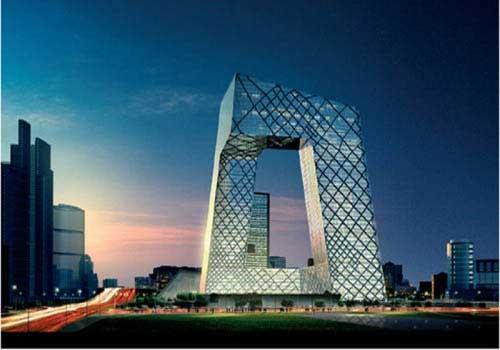
The new home of China Central Television (CCTV) is located in the busy commercial
area near the World Trade Center in Beijing's CBD.
The new home of China Central Television (CCTV) is located in the busy commercial area near the World Trade Center in Beijing's CBD. The tower, designed by Dutch architect Rem Koolhaas, is like two huge inverted "L's" connecting together. This remarkable concept, a breakaway from the traditional design of skyscrapers, presents a fresh image to local residents and attracts people's eyes miles away.
234 meters high, the building has 52 floors above ground and three floors underground, covering an area of more than 470,000 square meters. Unfortunately, the building caught fire on February 9, 2009, and is still under restoration.
Travel tips:
Open Hours: Not yet open to the public.
Getting there: Subway Line 1 to Guomao Station, then take Bus No. 402, 405, 107, 421.
NO.9 Capital Museum
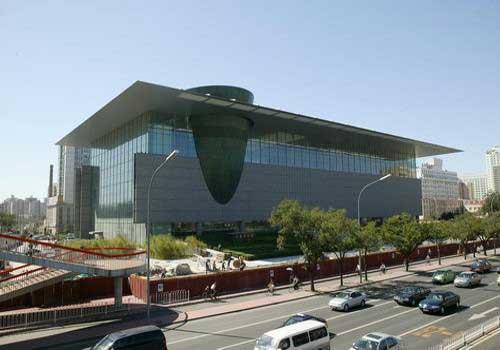
Being China's second largest museum, Capital Museum is situated in the center of
Xicheng District.
Being China's second largest museum, dwarfed only by the National Museum, Capital Museum is situated in the center of Xicheng District. After nearly four years construction, the new Capital Museum reopened in May 2006 at a cost of 1.23 billion yuan (about 187 million U.S. dollars). With an area of more than 60,000 square meters, the museum consists of Central Ritual Hall, Exhibition Hall, Multifunction Hall, Cultural Heritages Storehouse and Digital Movie Hall. There are more than 5,622 culture relics on display.
Travel tips:
Open Hours: 9:00 to 17:00 (Closed on Monday)
Admission: free (reservations needed)
Reservation: By phone via +86-010-6339 3339 between 9:00-17:00 or by online at http://www.capitalmuseum.org.cn/zjsb/pwfw.htm (Chinese)
Tel: +86-010-6337 0491; +86-010-63370492
Getting there: Bus No. 1, 4, 37, 52 to Gonghuidalou; No. 26, 319, 650, 708, 717, 727, 937 to Baiyunlu; or take subway Line 1 to Muxidi Station.
NO.8 National Indoor Stadium
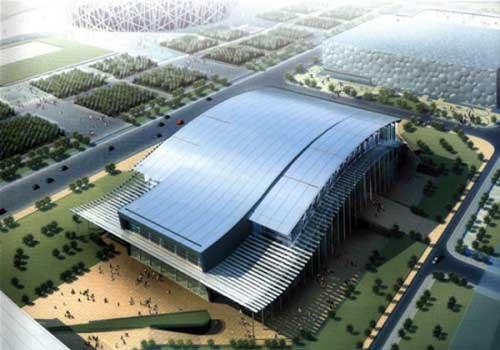
As a neighbor of the Bird's Nest and the Water Cube, the National Indoor Stadium is
also a part of the Olympic Park.
As a neighbor of the Bird's Nest and the Water Cube, the National Indoor Stadium is also a part of the Olympic Park. It is nicknamed the Fan, (Chinese: "shanzi"), due to its design resembling a traditional Chinese folding fan. The steel roof of the National Indoor Stadium is 144 meters long from north to south and 114 meters wide from east to west, consisting of 2,800 tons of steel.
After two and a half years of construction, the indoor stadium opened on November 26, 2007. In the 2008 Beijing Olympic Games, the stadium hosted the gymnastics, trampoline, handball, and volleyball competitions. Now, it is used for sports competitions, cultural and entertainment events, and as a multifunctional exercise center for local residents.
Travel tips:
Open Hours: only for events.
Getting there: Subway Line 8 to Olympic Park or Olympic Sports Center.
NO.7 Beijing South Railway Station
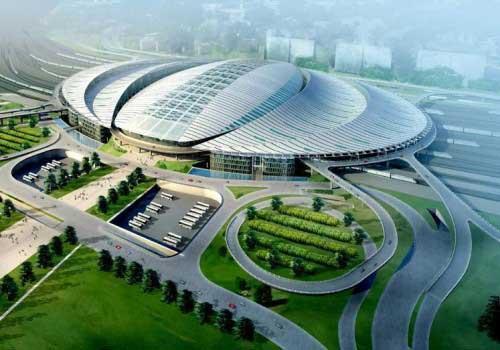
Beijing South Railway Station is located in Fengtai District.
Construction of the Beijing South Railway Station, in Fengtai DistrictBeijing South Railway Station, in Fengtai District, began in June, 2006 with an investment of 6.3 billion yuan (959 million U.S. dollars). Covering an area of 499,000 square meters, the South Railway Station is the second largest in the capital after Beijing's West Railway Station.
It has 13 platforms and 24 arrival and departure lines, and consists of two floors above ground and three floors underground. On August 1, 2008, the station was put into use and now serves as the terminal for the inter-city express rail between Beijing and Tianjin. In the future, it will become a high-speed rail terminal for the Beijing-Shanghai route.
Getting there: Bus No. 20, 54, 102, 106, 381; or take subway Line 4 to South Railway Station.
NO.6 National Library (second phase)
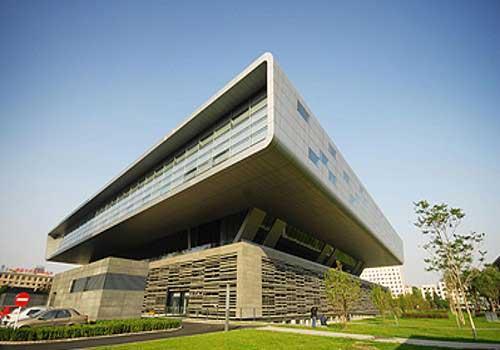
A brand-new extension of China's National Library opened on September 9, 2007.
A brand-new extension of China's National Library opened on September 9, 2007. Designed by a German architectural firm, the modern library is the world's biggest Chinese literature collection center and digital resource base, as well as the most advanced network service base in China. Located in southern Haidian District and covering an area of 80,538 square meters, the new library can seat 2,900 readers and accept 8,000 visitors a day.
The new addition makes the total construction area of the National Library over 250,000 square meters, ranking third in the world, only behind the U.S. Library of Congress and the Russian State Library.
Travel tips:
Open Hours: 9:00 to 21:00 (Monday to Friday); 9:00 to 17:00 (Saturday and Sunday)
Tel: +86-010-8854 5426; +86-010-8854 5360
Web: http://www.nlc.gov.cn/en/index.htm
Getting there: Bus No. 86, 319, 320, 332, 563, 645, 653, 689, 695, 697, 717, 808 and 814; or take subway Line 4 to National Library Station.
NO.5 Beijing Int'l Airport Terminal 3
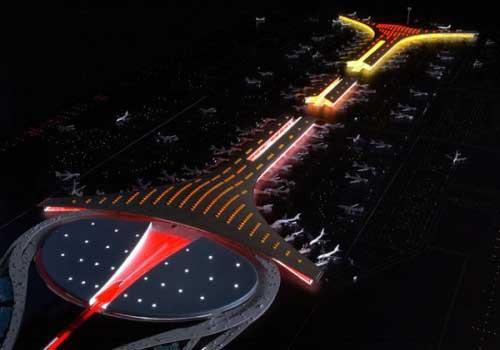
Terminal 3 of Beijing International Airport started construction on March 28, 2004,
and became fully operational on March 26, 2008.
Terminal 3 of Beijing International Airport started construction on March 28, 2004, and became fully operational on March 26, 2008, when Air China, Shanghai Airlines, other Star Alliance members and other international airlines moved in. Designed by Netherlands Airport Consultants B.V. (NACO) and UK Architect Norman Foster, Terminal 3 is one of the world's most environmentally sustainable airport buildings, designed to accommodate Beijing's cold winters, hot summers, short autumn and spring seasons.
It consists of three main passenger terminals (Terminal 3A, 3B and 3C) and two satellite concourses (Terminal 3D and Terminal 3E).
Getting there: Airport Train from Dongzhimen or Sanyuanqiao.
NO.4 National Center for Performing Arts
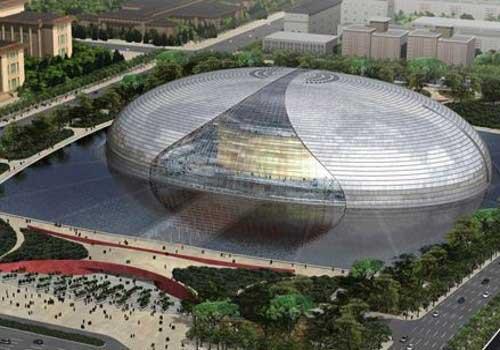
Situated in the heart of the capital, the National Center for Performing Arts is
Beijing's foremost cultural center.
Situated in the heart of the capital, next to Tian'anmen Square, the National Center for Performing Arts is Beijing's foremost cultural center. Designed by architect Paul Andreu, the theater has been one of the most talked-about architectural projects for years, because of Andreu's audacious and innovative design and the project's grand scope.
The curved building features a titanium shell and emerges like an island at the center of a lake. The theater houses three performance auditoria - a 2,416-seat opera house, a 2,017-seat concert hall and a 1,040-seat theater - as well as art and exhibition spaces.
Travel tips:
Open Hours: 9:00 to 17:00 (closed on Monday)
Admission: 30 yuan for adults; 15 yuan for children
Tel: +86-010-6655 0989; +86-010-6655 0000 (ticket reservation)
Web: http://www.chncpa.org/n457779/index.html
Getting there: Bus 1, 4, 10, 20, 37, 52, 726, 728 and 802 to Tian'anmen West; or take subway Line 1 to Tian anmen West Station, Exit C.
NO.3 National Aquatic Center (Water Cube)
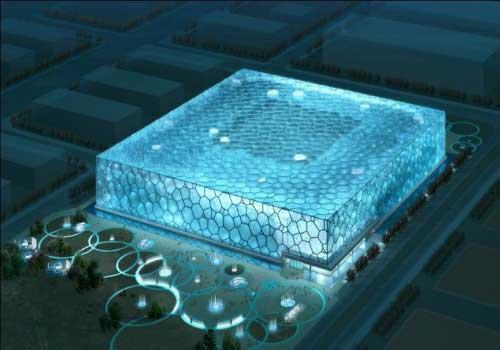
The National Aquatics Center, also known colloquially as the Water Cube, was a major
venue for the 2008 Olympic Games.
The National Aquatics Center, also known colloquially as the Water Cube, was a major venue for the 2008 Olympic Games. After over four years of construction, the building was completed on January 28, 2008. The Water Cube comprises over 100,000 square meters of ETFE foils, making it the single largest, most complicated and most comprehensive ETFE structure in the world.
The venue was used for swimming, diving, water polo and synchronized swimming competitions during the 2008 Olympic Games. In daylight, the Water Cube shines as a translucent blue spectacle; while at night, the glow of its LED bubbles creates a spectacular visual effect.
Travel tips:
Open Hours: 9:00 to 21:00
Admission: 30 yuan for adults; 15 yuan for students
Getting there: Bus 386, 656, 660, 689, 740, 753, 804, 827, 939, 944 or 983 to Beichenqiaoxi Stop; or take subway Line 8 to Olympic Sports Center Station, Exit B1.
NO.2 National Stadium (Bird's Nest)
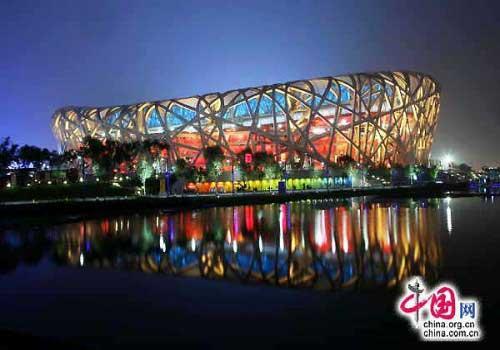
The National Stadium, as the main track and field stadium for the 2008 Olympics Games,
is dubbed the "bird's nest" because of its innovative grid formation.
The National Stadium, as the main track and field stadium for the 2008 Olympics Games, is dubbed the "bird's nest" because of its innovative grid formation. The twig-like structural elements and the bowl-shaped roof are the masterpiece of the project, yet they posed great challenges for technicians and workers during construction. The stadium was begun in March 2004 and finished in March 2008. It was built with 36 kilometers of unwrapped steel, with a combined weight of 45,000 tonnes. Covering over 258,000 square meters, the stadium has at least 100,000 seats.
Travel tips:
Open Hours: 9:00 to 18:00
Admission: 50 yuan; 25 yuan for students
Getting there: Bus 386, 656, 660, 689, 696, 740, 753, 939, 944 or 983 to Yayuncun Stop; or take subway Line 8 to Olympic Sports Center Station, Exit B2.
NO.1 National Museum
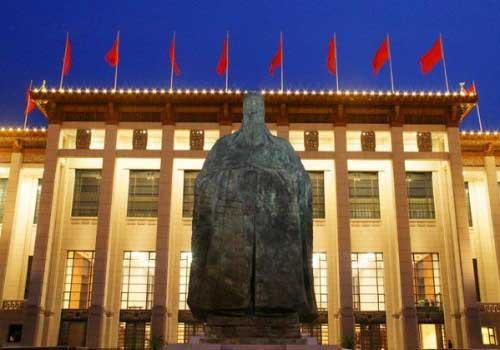
Standing on the east side of Tian'anmen Square, the National Museum is one of the most
historic buildings in the capital.
Standing on the east side of Tian'anmen Square, the National Museum is one of the most historic buildings in the capital. The old buildings of the National Museum used to be divided into the National Museum of Chinese History and the National Museum of Chinese Revolutionary History, both of which were founded in 1959.
After three years reconstruction, new National Museum opened in March 2011. The current museum nearly triples the size of the complex from 65,000 square meters to almost 200,000 square meters, and the number of exhibition rooms increase to 49. It has four floors above ground and two floors underground, housing an 800-seat theater, a 300-seat academic lecture hall and a 600 square-meter studio.
Travel tips:
Open Hours: 9:00 to 17:00 (closed on Monday)
Admission: free, reservations needed
Web: http://www.chnmuseum.cn/default.aspx (Chinese)
Getting there: Bus No. 1, 2, 10, 20, 37, 52, 59, 82, 99, 120, 126, 728 to Tian'anmen East Stop; No. 5, 17, 20, 22, 48, 59, 66, 69, 71, 82, 120, 126, 301, 626, 646, 690, 692 to Qianmen Stop; or take Subway Line 1 to Tian anmen East Station, Line 2 to Qianmen Station.
Related News
Photos
More>>history
- SCUT students win Silver Prize in the 8th China Environmental Art Design Prize
- SBC-MCC Bids for Belgium Pavilion in Shanghai Expo Venue
- 2010 Ho Leung Ho Lee Foundation Award Presentation Ceremony Held in Beijing; AE
- SFIC and SPRING lead first furniture design mission to Scandinavia
- Shanghai Gets 'Design City' Title





